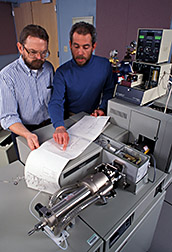Good Earth
|
|
The earthy smell of healthy soil is linked to two filamentous microbes.
Fertile soil's distinctive earthy odor may someday give farmers and gardeners something like a simple scratch-and-sniff test for assessing soil health.
"For years, farmers have relied on the smell of soil as a sign of its health and vitality. We're developing an odor-based soil test that is a barometer of organic activity—a vital sign of healthy soil," says ARS microbiologist Peter D. Stahl.
"Our tests show that of the many gases coming from soil, two make up this earthy odor—although other gases may contribute. The human nose is so sensitive to geosmin and 2-methylisoborneol, it can detect these gases in soil at parts-per-billion concentrations," he says. "That's about a drop or two in a railroad tanker full of water."
It's the first time the two earthy-smelling gases have been used as indicators of microbial activity in soil. Now, Stahl and colleagues are working to find out what in soil is making these tell-tale gases.
He and microbiologist Timothy B. Parkin worked for over 2 years perfecting a technique to purge, trap, and measure geosmin and 2-methylisoborneol. They first screened more than 25 gases escaping from soils.
"We captured 15 percent of the geosmin and 24 percent of the 2-methylisoborneol. That may not seem like a lot, but it is the most yet reported from extracting these gases from soil," Parkin says.
"Our studies indicate that the distinctive earthy odors are a gaseous byproduct of two groups of soil microorganisms—fungi and actinomycetes," Stahl says.
These filamentous microbes are plentiful in healthy soil, forming up to a mile or more of filaments in just a cubic inch.
Millions of these microbes per cubic inch of soil emit the earthy odors as they decompose dead plants and animals and recycle their nutrients. Other soil organisms produce a variety of additional gases and odors.
He says that besides waste by-products, he is not sure of the exact role of these gases, although they may have antibiotic or stimulatory effects on other soil organisms.
After measuring the gases, the researchers counted the microbes—fungal hyphae and actinomycete filaments—in both a woodland and cropped soil.
Parkin says, "We found that the virgin woodland soil had higher amounts of both gases, which agrees with these microbes' greater numbers." Virgin soil produced over 20 times the gases that cropland did.
According to Parkin, since both gases are by-product of microbes' metabolism, gas-production levels may be a better indicator of microbial activity than their numbers or biomass. "Besides nutrient cycling, which enriches the soil, these microbes keep soil stable and prevent erosion," he says.
A healthy soil ecosystem relies not only on microbes but also on fellow soil workers like earthworms, insects, bacteria, and nematodes. They all live together in soils to break down organic matter, Parkin adds.
"We're also using selective antibiotics to manipulate soil microbial communities in the laboratory to find out which organisms are producing other odor-causing compounds," he says. The scientists believe this information may prove valuable in assessing the activity of other important soil organisms. -- By Hank Becker, ARS.
Timothy B. Parkin is at the USDA, ARS National Soil Tilth Laboratory, Room 316, 2150 Pammel Dr, Ames, IA, 50011-3120; phone: (515) 294-6888, fax: (515) 294-8125
"Good Earth" was published in the June 1995 issue of Agricultural Research magazine.







